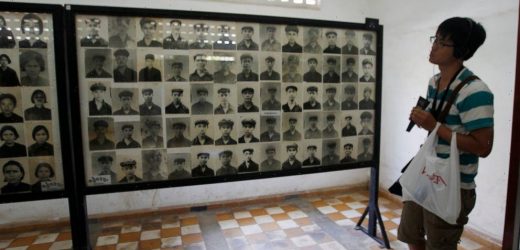PHNOM PENH, Cambodia — Cambodians on Monday continued to condemn an Irish photo restorer for altering photographs of victims of their country’s 1970s genocide to show them smiling, saying his decision and that of an international media group to publish them showed horrible judgement.
Vice on Friday published an interview with Matt Loughrey, who had colorized photos taken of prisoners of the Khmer Rouge’s notorious S-21 prison in Phnom Penh, where an estimated 17,000 people suspected of being enemies of the communist regime were jailed and tortured before being executed.
Vice has since taken the article off its website and released a statement saying it was investigating the issue.
“To imagine the smiling faces of victims of the Khmer Rouge, your judgment then must be horrible,” Youk Chhang, director of the Documentation Center of Cambodia, said Monday.
Youk Chhang’s center has a vast trove of evidence of atrocities committed by the Khmer Rouge, who are blamed for the deaths of an estimated 1.7 million of their countrymen through execution, starvation, overwork and lack of medical care. After winning a civil war and taking power in 1975, the group’s paranoid leaders blamed the failure of their utopian plans on enemies, and purges were constant until a Vietnamese invasion unseated them in 1979.
The controversy over the photos has raised questions about what limits there should be on the manipulation of historical images, an especially sensitive issue in the case of Cambodia, where the trauma from the brutality is still evident.
“A lesson we learn from this is that we must accept the fact that the Khmer Rouge is NOT about the past,” Youk Chhang told The Associated Press in an email. “How can it be about the past, when we have at least five million survivors of the Khmer Rouge are still alive today?”
In his interview with Vice, Loughrey said he had been hired by family members of some of the S-21 victims to colorize photos of their loved ones, and he then on his own worked on more images from the prison, which today is the Tuol Sleng Genocide Museum. The Associated Press was unable to reach him Monday for comment.
Several colorized photos accompanying the article showed S-21 prisoners smiling for the camera, and Loughrey volunteered his thoughts to Vice’s interviewer about why they might have been smiling.
“The women tended to have a smile on their face more so than the men,” he told Vice. “I think a lot of that has to do with nervousness.”
The article set off alarms bells with people familiar with the collection of the original black and white photos, including professional photographer John Vink, who has worked in Cambodia. They pointed out that in at least some of the original photos, the subjects were not smiling, and Loughrey not only colorized the photos but retouched them to alter their expressions
“Matt Loughrey in Vice is not colourising S21 photographs. He is falsifying history,” Vink commented Saturday on Twitter, showing examples of the originals and Loughrey’s altered versions with smiles.
Social media users in Cambodia jumped into the fray.
“The actions of the Matt Loughrey and @viceasia @vice really hurt me, my mother and the entire Cambodian community that still deeply suffer from the brutality of the Khmer Rouge,” tweeted Thida Leiper.
Signatures were solicited for an online petition demanding Vice take down the story with the photos and that Loughrey apologize.
On Sunday, Cambodia’s Ministry of Culture and Fine Arts issued a statement, saying it “does not accept this kind of manipulation, and considers this work of Matt Lougnrey to seriously affect the dignity of the victims, the reality of Cambodia’s history, and in violation of the rights of the Museum as the lawful owners and custodians of these photographs.”
It said that use of the S-21 photos was regulated under Cambodian law, and warned that unless Loughrey and Vice took the images offline it would consider legal action against them.
“We urge researchers, artists and the public not to manipulate any historical source to respect the victims,” the ministry said.
By Monday, Vice had taken down the story and posted a statement in its place.
“The article included photographs of Khmer Rouge victims that Loughrey manipulated beyond colorization,” it acknowledged. “The story did not meet the editorial standards of VICE and has been removed. We regret the error and will investigate how this failure of the editorial process occurred.”
Source: Read Full Article


